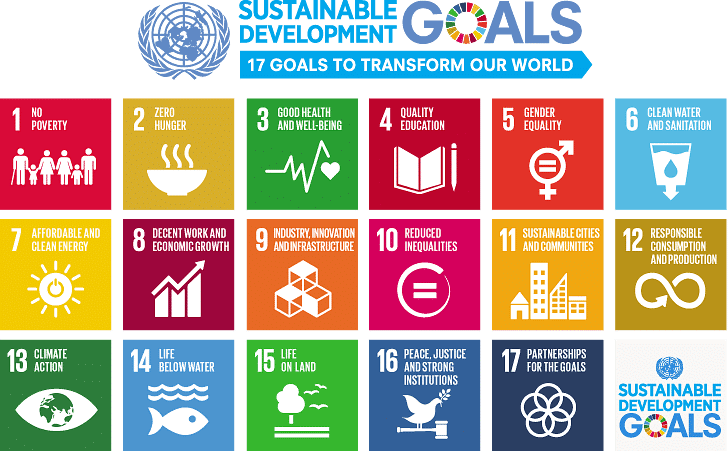The Hindu Editorial Analysis- 4th May 2024 | Current Affairs & Hindu Analysis: Daily, Weekly & Monthly - UPSC PDF Download

This is the year to get the SDG goals back on track
Why in News?
The United Nations summit on Sustainable Development Goals (SDG), that was held in New York (September 18-19), assessed progress towards achieving the SDGs. The Agenda-2030, which was adopted by the UN General Assembly in 2015, identified 17 SDGs with 169 specific targets to be achieved by 2030. The programme is internationally non-binding, but all countries have committed to work towards these goals as transiting to sustainable development is a common global endeavour.
- Sustainable Development Goals (SDGs) are a group of 17 global objectives set by the United Nations (UN) to address various social, economic, and environmental challenges faced by the world today. These goals provide a shared blueprint for countries to work together toward creating a more equitable, inclusive, and sustainable world by 2030.
History of Sustainable Development Goals
The history of the Sustainable Development Goals dates back to 2000 when the UN adopted the Millennium Development Goals (MDGs) to address global poverty, hunger, and education. However, the MDGs had some limitations, leading to the development of a more comprehensive and universal set of goals. The 17 Sustainable Development Goals were introduced in 2015, with the aim of addressing a broader range of issues, including climate change, economic inequality, and sustainable consumption. The SDGs build on the success and lessons learned from the MDGs and serve as a global commitment toward achieving a better and more sustainable future for all.
Similarities and Differences between MDGs and SDGs:
Similarities:
- Zero Goals: Both MDGs and SDGs share the overarching aim of addressing global challenges to improve living conditions and achieve sustainable development. However, the SDGs aim to completely eradicate certain issues rather than achieving partial progress.
- Global Agendas: Both initiatives represent global commitments and agendas endorsed by the international community, emphasizing collective efforts to address shared challenges.
- International Collaboration: Both MDGs and SDGs call for international collaboration, partnerships, and cooperation to achieve their respective targets.
- Participatory Process: The process of creating the SDGs involved a more inclusive and participatory approach, engaging a wide range of stakeholders, including governments, civil society, businesses, and academia. The MDGs, in contrast, were developed in a more top-down manner.
- Holistic Approach: SDGs adopt a more holistic and interconnected approach to sustainable development, recognizing the interdependence of social, economic, and environmental factors. MDGs were often criticized for their siloed approach.
- Separation of Goals: SDGs distinguish between hunger and poverty, treating them as separate issues. MDGs combined these elements under a single goal (MDG 1).
- Funding Strategy: While the MDGs relied heavily on aid flows, the SDGs emphasize sustainable, inclusive economic development and stress the role of countries in generating their revenue to address social challenges.
- Inclusion of Peace-Building: SDGs incorporate the goal of peace-building, recognizing the critical link between peace and the success of ending hunger and poverty. MDGs did not explicitly address peace-building.
- Data Revolution: SDGs place a strong emphasis on a “Data Revolution,” calling for improved monitoring, evaluation, and accountability. This was not explicitly addressed in the MDGs.
- Quality Education: Unlike the MDGs, which focused on quantitative aspects like enrollment rates, the SDGs introduce a focus on the quality of education and learning outcomes. The SDGs highlight the role of education in creating a more humane world.
Overall, the SDGs represent a more comprehensive and evolved framework, building on the lessons learned from the MDGs and incorporating a broader understanding of sustainable development.
NITI Aayog and SDGs:
- Coordination Role: NITI Aayog has been assigned the role of coordinating efforts for the implementation of the Sustainable Development Goals (SDGs) in India. This involves not only data collection but also proactive pursuit of the goals and targets.
- Collaboration with MoSPI: The Ministry of Statistics and Programme Implementation (MoSPI) is involved in the coordination efforts alongside NITI Aayog, indicating a collaborative approach in managing and monitoring SDGs.
- Mapping of Schemes: NITI Aayog has mapped various Centrally Sponsored Schemes (CSSs), including ‘core of the core,’ ‘core,’ and ‘optional’ schemes implemented by the states. This mapping aligns these schemes with the SDGs and ensures their contribution to the broader goals.
- International Commitment: As a signatory to the SDGs, India, through NITI Aayog, is committed to participating in the international review of progress on SDGs. The High-Level Political Forum (HLPF) serves as the central platform for international follow-up and review of the 2030 Agenda.
- Voluntary National Review (VNR): NITI Aayog, representing India, has presented the Voluntary National Review (VNR) on the implementation of SDGs at the HLPF. The VNRs are crucial for showcasing the country’s progress and achievements related to SDGs on the global stage.
- Core Objectives: The report highlights various measures and programs implemented across India to achieve the core objectives of the 17 SDGs. These include initiatives related to poverty eradication, economic growth, ending hunger, achieving food security, gender equality, sustainable industrialization, and climate action.
- Key Programs Highlighted: The report specifically mentions key programs and initiatives such as the ‘Mahatma Gandhi National Rural Employment Guarantee Act,’ ‘Beti Bachao Beti Padhao,’ ‘Sagarmala,’ ‘Clean India’ campaign, and the Aadhaar Act. These programs contribute to addressing specific SDGs and align with the global goals.
NITI Aayog’s involvement signifies a comprehensive and strategic approach to integrate the SDGs into national policies and programs, ensuring a concerted effort to achieve sustainable development in India.
List of 17 Sustainable Development Goals
- No Poverty
- Zero Hunger
- Good Health and Well-being
- Quality Education
- Gender Equality
- Clean Water and Sanitation
- Affordable and Clean Energy
- Decent Work and Economic Growth
- Industry, Innovation, and Infrastructure
- Reduced Inequality
- Sustainable Cities and Communities
- Responsible Consumption and Production
- Climate Action
- Life Below Water
- Life on Land
- Peace, Justice, and Strong Institutions
- Partnerships for the Goals

Goals of Sustainable Development
GOAL 1: No Poverty
The first of the 17 Sustainable Development Goals aim to eradicate extreme poverty for all people everywhere by 2030. Poverty is a multidimensional issue, and this goal focuses on creating policies that address income generation, access to basic services, and social protection. Sustainable Development Goals India is committed to reducing poverty by promoting social and economic inclusion through various programs and schemes.
GOAL 2: Zero Hunger
The second goal aims to end hunger, achieve food security, and promote sustainable agriculture. Zero Hunger involves increasing agricultural productivity, improving the resilience of food systems, and ensuring access to nutritious and sufficient food for all. India plays a significant role in achieving this goal by implementing policies and programs to improve food security and agricultural sustainability.
GOAL 3: Good Health and Well-being
The third goal seeks to ensure healthy lives and promote well-being for all, regardless of age. This involves reducing maternal and child mortality, fighting against communicable and non-communicable diseases, and promoting mental health. India has made significant strides in improving healthcare access and outcomes, contributing to the achievement of the Sustainable Development Goals 2030.
GOAL 4: Quality Education
The fourth goal aims to provide inclusive and equitable quality education, as well as promote lifelong learning opportunities for all. Sustainable Development Goals Quality Education focuses on increasing access to education, improving learning outcomes, and reducing gender disparities in educational opportunities. India has made considerable progress in this area through various policies and initiatives.
GOAL 5: Gender Equality
The fifth goal strives to achieve gender equality and empower all women and girls. This goal addresses various forms of discrimination, violence, and harmful practices against women, while also promoting women's participation in leadership roles and decision-making. India has been working towards gender equality through various policies, legislation, and awareness campaigns.
GOAL 6: Clean Water and Sanitation
The sixth goal aims to ensure the availability and sustainable management of water and sanitation for all. This involves improving water quality, increasing water-use efficiency, and protecting water-related ecosystems. India has undertaken numerous initiatives to improve access to clean water and sanitation, contributing to the United Nations Sustainable Development Goals.
GOAL 7: Affordable and Clean Energy
The seventh goal seeks to ensure access to affordable, reliable, sustainable, and modern energy for all. This includes increasing the share of renewable energy, improving energy efficiency, and ensuring universal access to clean energy services. India has made significant progress in expanding its renewable energy capacity and promoting energy efficiency.
GOAL 8: Decent Work and Economic Growth
The eighth goal aims to promote sustained, inclusive, and sustainable economic growth, full and productive employment, and decent work for all. This involves improving labor market conditions, supporting entrepreneurship, and fostering innovation. India has implemented various policies and programs to boost economic growth, create jobs, and enhance workers' rights.
GOAL 9: Industry, Innovation, and Infrastructure
The ninth goal focuses on building resilient infrastructure, promoting inclusive and sustainable industrialization, and fostering innovation. This includes increasing access to information and communication technology, supporting research and development, and promoting sustainable industrial practices. India has been investing in infrastructure development and promoting a culture of innovation to achieve this goal.
GOAL 10: Reduced Inequality
The tenth goal aims to reduce inequality within and among countries by promoting social, economic, and political inclusion. This involves ensuring equal opportunities, eliminating discriminatory policies, and fostering global partnerships for development. India has been working to reduce income inequality and promote social inclusion through various policies and programs.
GOAL 11: Sustainable Cities and Communities
The eleventh goal seeks to make cities and human settlements inclusive, safe, resilient, and sustainable. This involves ensuring access to affordable housing, improving urban planning, and enhancing the sustainability of cities. India has launched several initiatives to address urbanization challenges and promote sustainable urban development.
GOAL 12: Responsible Consumption and Production
The twelfth goal aims to ensure sustainable consumption and production patterns by promoting resource efficiency, reducing waste, and encouraging sustainable business practices. India has been working to implement sustainable production and consumption practices through various policies, regulations, and awareness campaigns.
GOAL 13: Climate Action
The thirteenth goal focuses on taking urgent action to combat climate change and its impacts by reducing greenhouse gas emissions, enhancing climate resilience and supporting climate adaptation efforts. India has been actively involved in international climate negotiations and has implemented various domestic initiatives to address climate change.
GOAL 14: Life Below Water
The fourteenth goal aims to conserve and sustainably use the oceans, seas, and marine resources for sustainable development. This includes preventing marine pollution, protecting marine ecosystems, and ensuring sustainable fisheries. India has been working to protect its marine resources and ecosystems through various conservation and sustainable management efforts.
GOAL 15: Life on Land
The fifteenth goal focuses on protecting, restoring, and promoting sustainable use of terrestrial ecosystems, halting biodiversity loss, and combating desertification. India has made significant efforts in forest conservation, wildlife protection, and promoting sustainable land management practices.
GOAL 16: Peace and Justice Strong Institutions
The sixteenth goal seeks to promote peaceful and inclusive societies, provide access to justice for all, and build effective, accountable, and inclusive institutions. India has been working towards ensuring the rule of law, reducing corruption, and enhancing transparency and accountability in its institutions.
GOAL 17: Partnerships to achieve the Goal
The seventeenth goal emphasizes the importance of global partnerships to support and achieve Sustainable Development Goals. This includes enhancing international cooperation, promoting sustainable development investments, and fostering multi-stakeholder partnerships. India has been actively engaged in international partnerships and collaborations to achieve the 17 Sustainable Development Goals.
Overall Commitment: India’s VNR demonstrates a commitment to addressing a wide range of SDGs through targeted programs and initiatives. The emphasis on economic growth, poverty eradication, gender equality, health, innovation, and global partnerships reflects a holistic approach to sustainable development in the country. The VNR also highlights the interconnectedness of these goals and the need for collaborative efforts to achieve them.
|
52 videos|5374 docs|1136 tests
|















